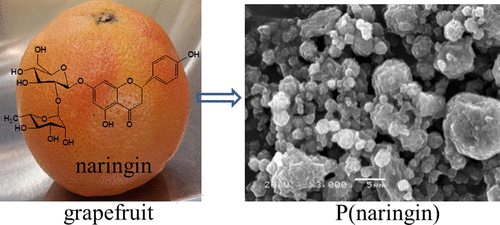Our official English website, www.x-mol.net, welcomes your feedback! (Note: you will need to create a separate account there.)
Fabrication of Biodegradable Poly(naringin) Particles with Antioxidant Activity and Low Toxicity
ACS Omega ( IF 4.1 ) Pub Date : 2018-12-14 00:00:00 , DOI: 10.1021/acsomega.8b02292 Mehtap Sahiner 1 , Nurettin Sahiner 2 , Selin Sagbas , Mitchell L. Fullerton 1 , Diane A. Blake 1
ACS Omega ( IF 4.1 ) Pub Date : 2018-12-14 00:00:00 , DOI: 10.1021/acsomega.8b02292 Mehtap Sahiner 1 , Nurettin Sahiner 2 , Selin Sagbas , Mitchell L. Fullerton 1 , Diane A. Blake 1
Affiliation

|
Naringin (NR, 4′,5,7 trihydrocyflavanone-7-O-rhamnoglucoside) is a flavanone found in citrus fruit that is composed of a phenolic compound, naringenin, and a disaccharide, neohesperidose. Poly(NR) [p(NR)] particles in the size range of few micrometers to few hundred nanometers were prepared from highly purified NR and subsequently characterized using UV/visible spectroscopy, Fourier transform infrared spectroscopy, nuclear magnetic resonance spectroscopy, scanning electron microscopy, thermogravimetric analysis, and zeta potential measurements. The hydrolytic degradation of p(NR) particles at 37.5 °C was investigated at pHs 5.4, 7.4, and 9.0. The particles degraded most rapidly at pH 7.4, with >90% degradation after 5 h. The cytotoxicity was assessed by growing COS-1 fibroblasts for 5 days in the presence of increasing concentrations of NR or eluates from the p(NR) particles. Both NR and p(NR) particles were nontoxic for these mammalian fibroblasts; at the highest concentration tested (571 μg/mL), the percentages of surviving cells after 5 days in culture were 96.7 ± 0.93 and 91 ± 11% for NR and p(NR), respectively. The effect of p(NR) on red blood cell hemolysis was also negligible (<2%) at concentrations up to 100 μg/mL; unpolymerized NR showed slightly higher levels of hemolysis than the p(NR) particles, but values never exceeded 5% at 50 and 100 μg/mL. Both NR and p(NR) stimulated blood coagulation in a dose-dependent manner; the hemostatic effect was greater for p(NR), which, at 100 μg/mL, stimulated in vitro blood clotting by ∼50%. Neither NR nor eluates from p(NR) particles inhibited α-glucosidase activity; in fact, both provided a modest (10–30%) stimulation at concentrations from 0.67 to 1.67 mg/mL. p(NR) particles are easily synthesized, break down readily at physiological pH, and have excellent blood and biocompatibility. As such, they will be a useful carrier for drug delivery and as an oral antioxidant supplement.
中文翻译:

具有抗氧化活性和低毒性的可生物降解聚柚皮苷颗粒的制备
柚皮苷(NR,4',5,7 trihydrocyflavanvanone-7- O-鼠李糖苷)是一种在柑桔类水果中发现的黄烷酮,由酚类化合物柚皮苷和二糖新橙皮苷组成。由高度纯化的NR制备了几微米至几百纳米大小的聚(NR)[p(NR)]颗粒,然后使用UV /可见光谱,傅里叶变换红外光谱,核磁共振光谱,扫描电子显微镜对它们进行了表征,热重分析和Zeta电位测量。在pH值为5.4、7.4和9.0的条件下研究了p(NR)颗粒在37.5°C下的水解降解。颗粒在pH 7.4时降解最快,在5 h后降解> 90%。通过在浓度不断增加的NR或来自p(NR)颗粒的洗脱液中生长COS-1成纤维细胞5天来评估细胞毒性。NR和p(NR)颗粒均对这些哺乳动物成纤维细胞无毒。在最高测试浓度(571μg/ mL)下,培养5天后NR和p(NR)存活细胞的百分比分别为96.7±0.93和91±11%。当浓度高达100μg/ mL时,p(NR)对红细胞溶血的影响也可以忽略不计(<2%);未聚合的NR的溶血水平略高于p(NR)颗粒,但在50和100μg/ mL时,溶血值从未超过5%。NR和p(NR)均以剂量依赖性方式刺激血液凝结。p(NR)的止血作用更大,其以100μg/ mL的浓度刺激体外血液凝结约50%。NR和来自p(NR)颗粒的洗脱液均不能抑制α-葡萄糖苷酶的活性。实际上,两者在0.67至1.67 mg / mL的浓度下均提供了适度(10-30%)的刺激。p(NR)颗粒易于合成,在生理pH值下容易分解,并且具有出色的血液和生物相容性。这样,它们将是用于药物递送和作为口服抗氧化剂补充剂的有用载体。
更新日期:2018-12-14
中文翻译:

具有抗氧化活性和低毒性的可生物降解聚柚皮苷颗粒的制备
柚皮苷(NR,4',5,7 trihydrocyflavanvanone-7- O-鼠李糖苷)是一种在柑桔类水果中发现的黄烷酮,由酚类化合物柚皮苷和二糖新橙皮苷组成。由高度纯化的NR制备了几微米至几百纳米大小的聚(NR)[p(NR)]颗粒,然后使用UV /可见光谱,傅里叶变换红外光谱,核磁共振光谱,扫描电子显微镜对它们进行了表征,热重分析和Zeta电位测量。在pH值为5.4、7.4和9.0的条件下研究了p(NR)颗粒在37.5°C下的水解降解。颗粒在pH 7.4时降解最快,在5 h后降解> 90%。通过在浓度不断增加的NR或来自p(NR)颗粒的洗脱液中生长COS-1成纤维细胞5天来评估细胞毒性。NR和p(NR)颗粒均对这些哺乳动物成纤维细胞无毒。在最高测试浓度(571μg/ mL)下,培养5天后NR和p(NR)存活细胞的百分比分别为96.7±0.93和91±11%。当浓度高达100μg/ mL时,p(NR)对红细胞溶血的影响也可以忽略不计(<2%);未聚合的NR的溶血水平略高于p(NR)颗粒,但在50和100μg/ mL时,溶血值从未超过5%。NR和p(NR)均以剂量依赖性方式刺激血液凝结。p(NR)的止血作用更大,其以100μg/ mL的浓度刺激体外血液凝结约50%。NR和来自p(NR)颗粒的洗脱液均不能抑制α-葡萄糖苷酶的活性。实际上,两者在0.67至1.67 mg / mL的浓度下均提供了适度(10-30%)的刺激。p(NR)颗粒易于合成,在生理pH值下容易分解,并且具有出色的血液和生物相容性。这样,它们将是用于药物递送和作为口服抗氧化剂补充剂的有用载体。



























 京公网安备 11010802027423号
京公网安备 11010802027423号